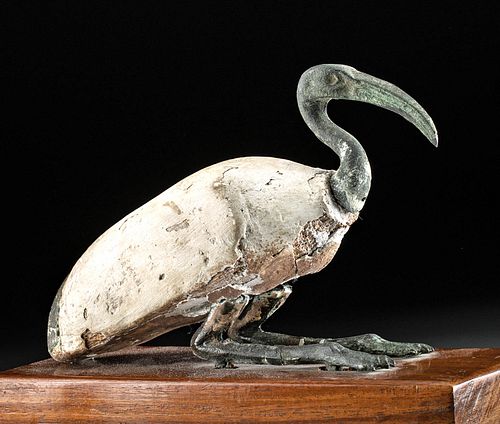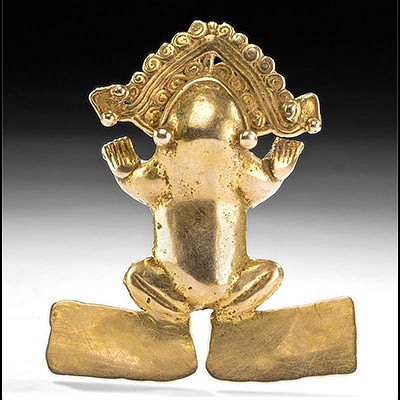Egyptian 25th Dynasty Bronze / Gesso'd Wood Sacred Ibis
Lot 1
About Seller
Artemis Fine Arts
686 S Taylor Ave, Ste 106
Louisville, CO 80027
United States
Selling antiquities, ancient and ethnographic art online since 1993, Artemis Gallery specializes in Classical Antiquities (Egyptian, Greek, Roman, Near Eastern), Asian, Pre-Columbian, African / Tribal / Oceanographic art. Our extensive inventory includes pottery, stone, metal, wood, glass and textil...Read more
Estimate:
$3,600 - $4,500
Absentee vs Live bid
Two ways to bid:
- Leave a max absentee bid and the platform will bid on your behalf up to your maximum bid during the live auction.
- Bid live during the auction and your bids will be submitted real-time to the auctioneer.
Bid Increments
| Price | Bid Increment |
|---|---|
| $0 | $25 |
| $300 | $50 |
| $1,000 | $100 |
| $2,000 | $250 |
| $5,000 | $500 |
| $10,000 | $1,000 |
| $20,000 | $2,500 |
| $50,000 | $5,000 |
| $100,000 | $10,000 |
| $200,000 | $20,000 |
About Auction
By Artemis Fine Arts
Aug 13, 2020
Set Reminder
2020-08-13 10:00:00
2020-08-13 10:00:00
America/New_York
Bidsquare
Bidsquare : Fine Antiquities, Ethnographic & Fine Art
https://www.bidsquare.com/auctions/artemis-gallery/fine-antiquities-ethnographic-fine-art-5415
Features classical antiquities, ancient and ethnographic art from cultures encompassing the globe. Egyptian, Greek, Roman, Etruscan, Near Eastern, Asian, Pre-Columbian, Native American, African / Tribal, Oceanic, Spanish Colonial, Russian, Fine Art, so much more! Artemis Fine Arts info@artemisgallery.com
Features classical antiquities, ancient and ethnographic art from cultures encompassing the globe. Egyptian, Greek, Roman, Etruscan, Near Eastern, Asian, Pre-Columbian, Native American, African / Tribal, Oceanic, Spanish Colonial, Russian, Fine Art, so much more! Artemis Fine Arts info@artemisgallery.com
- Lot Description
Egypt, Third Intermediate Period, Dynasty XXV, ca. 747 to 656 BCE. This seated sacred ibis votive, associated with the deity Djehuty or Thoth - the god of knowledge in the Egyptian pantheon, is comprised of a bronze head with concave circular eyes that likely once held inlays and a long bill supported by a sinuous neck, a hand-carved wooden body covered in white gesso, bronze legs and tailfeathers. The legs, head, and tail feathers were each cast separately and present finely delineated details. Take note of those webbed feet and intricate markings on tail feathers. Custom, wooden stand. Size (ibis): 6.875" L x 2.625" W x 4.625" H (17.5 cm x 6.7 cm x 11.7 cm); 7.25" H (18.4 cm) on included custom stand; (wooden stand): 9.25" L x 4" W x 2.7" H (23.5 cm x 10.2 cm x 6.9 cm)
The ibis, an elegant, long-legged wading bird that lives along the shores of the Nile, was associated with the god Thoth. He was the god of wisdom and writing, and in worship to him many thousands of ibises were ritually sacrificed, embalmed, and mummified before being buried in underground galleries. Thousands of these burials have been excavated at Sakkara, near Memphis, Egypt's ancient capital. This piece was a votive piece created to be placed inside a tomb.
Provenance: private East Coast, USA collection; ex-Attal private collection, Austin, Texas, USA via family descent from great uncle, acquired during first quarter of 20th century
All items legal to buy/sell under U.S. Statute covering cultural patrimony Code 2600, CHAPTER 14, and are guaranteed to be as described or your money back.
A Certificate of Authenticity will accompany all winning bids.
We ship worldwide and handle all shipping in-house for your convenience.
#157126Ibis body is removable from legs. Repairs to small areas of gesso primarily underneath body, with head reinserted into neck cavity, bronze panels reattached to butt end, and both legs repaired along midsection; chipping and light adhesive residue along some break lines. Both legs are adhered to mortises atop wooden stand and cannot be removed. Chipping and darkening to some areas of gesso and exposed wood, with light encrustations across head, body, and legs. Great patina to bronze components, and nice earthen deposits throughout.Condition
- Shipping Info
-
All shipping is handled in-house for your convenience. Your invoice from Artemis Gallery will include shipping calculation instructions. If in doubt, please inquire BEFORE bidding for estimated shipping costs for individual items.
-
- Buyer's Premium



 EUR
EUR CAD
CAD AUD
AUD GBP
GBP MXN
MXN HKD
HKD CNY
CNY MYR
MYR SEK
SEK SGD
SGD CHF
CHF THB
THB














